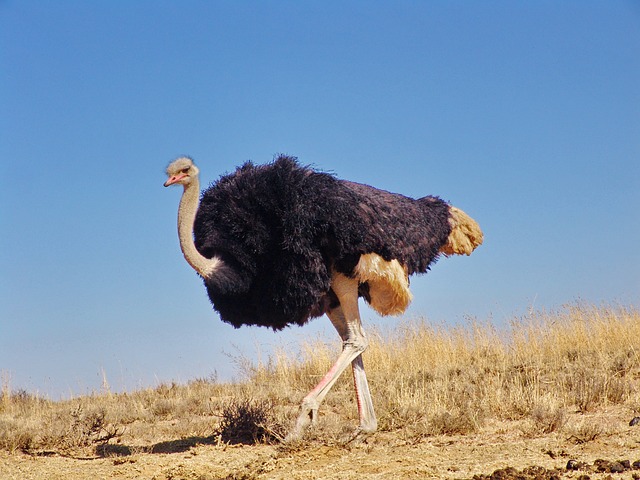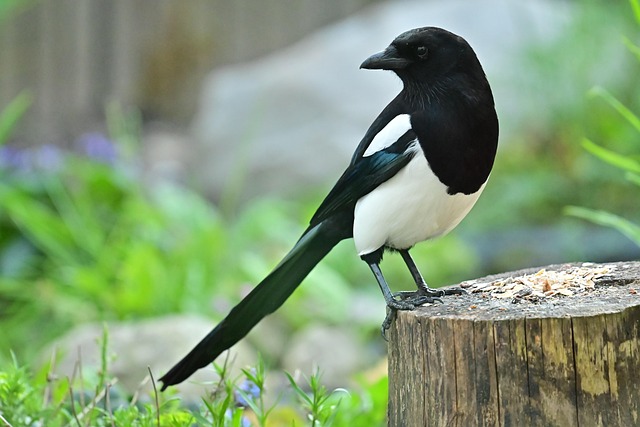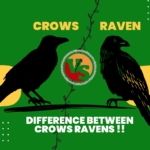The ostrich, a Struthio camelus, is the largest, heaviest, and flightless bird in the world due to its incredible speed, long legs, and unique adaptations. The ostrich is part of the ratite family, which includes other flightless birds such as the emu and the kiwi. Although it can’t fly, an ostrich is one of the fastest running birds on Earth, gaining a speed of up to 60 km/h (37 mph). They are best known for the unique look, the long necks, powerful legs, and large eyes that help them track predators some distance away.
In this article, we will learn about the life, age, height, weight, sound, types, eggs, habitat, area, and interesting and funny facts related to the life of Ostrich bird.
Know Everything About Flightless Bird, Ostrich

| Attribute | Information |
|---|---|
| Scientific Name | Struthio camelus |
| Common Name | Ostrich |
| Kingdom | Animalia |
| Phylum | Chordata |
| Class | Aves |
| Order | Struthioniformes |
| Family | Struthionidae |
| Genus | Struthio |
| Species | S. camelus |
| Native Region | Africa |
| Habitat | Savannas, deserts, and open grasslands |
| Lifespan | 40–50 years (wild), up to 70 years (captivity) |
| Size | 2.1–2.7 meters (6.9–8.9 feet) |
| Weight | 100–160 kg (220–350 lbs) |
| Wingspan | Around 2 meters (6.6 feet) |
| Speed | Up to 70 km/h (43 mph) |
| Diet | Herbivorous, eats plants, seeds, and insects |
| Reproduction | Lays the largest eggs of any bird |
| Egg Weight | 1.4 kg (3.1 lbs) |
| Incubation Period | 42–46 days |
| Number of Eggs Laid | 7–10 per clutch |
| Male Coloration | Black and white plumage |
| Female Coloration | Brown and gray plumage |
| Social Behavior | Lives in groups, known as flocks |
| Predators | Lions, cheetahs, hyenas, and humans |
| Defense Mechanism | Powerful kick, running at high speeds |
| Unique Feature | Largest flightless bird in the world |
| Commercial Uses | Feathers, meat, leather production |
| Endangered Status | Not endangered but declining in some areas |
| Eye Size | 5 cm (largest of any land animal) |
| Brain Size | Smaller than its eye |
| Sleep Pattern | Sleeps for short periods |
| Adaptability | Can survive without water for long periods |
| Communication | Uses booming calls and hissing sounds |
| Toe Count | Two toes per foot |
| Strength | Powerful legs capable of killing a predator |
| Vision Range | Can see up to 3.5 km (2.1 miles) |
| Domestication | Farmed for commercial products |
| Blood Circulation | Efficient cooling system to handle heat |
| Common in Zoos? | Yes, frequently found in wildlife parks |
| Brain-to-Body Ratio | Very small compared to other birds |
| Parental Care | Both males and females incubate eggs |
| Historical Importance | Used for riding in ancient times |
| Symbolism | Represents speed, strength, and endurance |
| Economic Value | High due to meat and leather trade |
| Common Myth | Does not actually bury its head in the sand |
Types of Ostriches
While only one species exists, the ostrich, with the name of Struthio camelus, several subspecies are available in which there may be some minute variations in the size, color, and location. Some main types include are:
- North African Ostrich (Struthio camelus camelus)– Largest of them, which Found in North Africa.
- Masai Ostrich (Struthio camelus massaicus) – Native of East Africa in Kenya and Tanzania.
- Somali Ostrich (Struthio molybdophanes) – These ostriches are from Horn of Africa; their skin contains a bluish tinge.
- South African Ostrich (Struthio camelus australis) – Common in South Africa and Namibia.
- Arabian Ostrich (Struthio camelus syriacus) (Extinct) – Once found in the Middle East, now extinct due to hunting.
Interesting, And Funny Facts About Ostriches
- Fastest Bird on Land: The ostrich is the fastest bird on land, able to run up to 70 km/h or 43 mph. They can weigh as much as 1.4 kg (3.1 lbs) for an ostrich egg, equivalent to two dozen chicken eggs. An ostrich’s kick is powerful enough to kill a lion.
- Only Two-Toed Bird: Ostriches have two toes, whereas other birds have three or four.
- Largest Eyes of Any Land Animal: Their eyes are larger than their brains, and are about 5 cm in diameter.
- Survives Without Water for Days : Ostriches can go for long periods without drinking water as they obtain moisture from their food.
- Male ostriches roar like lions : They make deep, booming sounds that can be mistaken for a lion’s roar.
- Ostrich feathers do not have barbs : Unlike other birds, their feathers are fluffy and soft because they lack the ability to lock together.
- Can change running direction instantly : Their flexible legs allow them to change direction at high speeds without falling.
- Ostriches Don’t Burry Their Heads in the Sand – They simply stoop their heads down to the ground so that they can blend into their surroundings.
- Ostrich Farms Exist Worldwide – Ostriches are commercially farmed for meat, leather, and feathers.
- They Are Omnivores – Although primarily herbivorous, at times they feed on small insects and lizards.
FAQ’s
Ostriches are the fastest running birds globally and can go up to a speed of 70 km/hr. They produce the largest egg, have incredibly powerful legs used for self-defence, and have the world’s largest land animal eyes.
Ostriches are omnivorous, mainly feeding on plants, seeds, roots, and fruits. They also eat insects, small reptiles, and carrion from time to time. Since they do not have teeth, they swallow pebbles to help grind food in their powerful gizzard for digestion.
Ostriches do not fly because their bodies are so large and huge, and their wings are relatively short and thin; they cannot provide the necessary power for flying. However, ostriches have very strong legs that help them to run very fast at around 70 km/h.
The female ostrich is called a hen, while the male is called a rooster. Hens are generally smaller than males, and they often have brown or grayish feathers that help to camouflage them against their surroundings to protect them from predators.
Despite the ostrich’s speed and strength, there are a few weaknesses. Its major weakness is its inability to fly, leaving it exposed to predators. Long legs, although powerful, can be easily injured. The reliance on vision makes them less effective in low light.
In the wild, ostriches have an expected life span of 40 to 50 years while in captivity; with proper care, they can live up to 70 years. This lifespan depends on habitat, diet, and protection from predators.
Male ostriches have beautiful black feathers with white wingtips and tail feathers, while females have brown or grayish plumage. This difference in color helps females blend in with their surroundings for better camouflage while nesting.
Ostriches don’t have any teeth. What they do have are small pebbles and grit that are swallowed, where these help in grinding down the food in a stomach organ specialized to aid digestion called the gizzard.
Ostriches have two stomachs; one is known as the gizzard, used to grind down food with its swallowed stones inside, and another glandular stomach that secretes digestive enzymes and breaks down what has been swallowed before it actually goes into the intestines.
Yes, ostriches lay eggs. But more specifically, they lay the largest eggs of any bird species. An ostrich egg weighs approximately 1.4 kg (3.1 lbs) and can be up to 15 cm (6 inches) in diameter, as well as having a hard, protective shell.
Conclusion
Ostriches, with their great speed, giant size, and peculiar forms, are indeed remarkable creatures. For millions of years, they have existed, and their flightless still remains a source of attraction in both their natural habitat and captivity. With their population being stable, protection of their natural habitats from human development would be very crucial. Whether one appreciates their muscular legs, enormous eggs, or monetary worth, the ostrich remains one of the most fascinating birds on the planet.
These unique characteristics make ostriches of great interest to scientists, wildlife enthusiasts, and bird lovers alike. Whether they are found in the wild or on farms, they are a vital part of the ecosystem and global economy. If you ever get a chance to see one up close, you will realize just how amazing these giant birds are!









